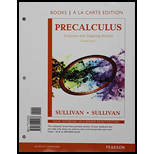
Concept explainers
Analyzing the Motion of a Projectile A projectile is fired at an inclination of to the horizontal, with a muzzle velocity of 100 feet per second. The height of the projectile is modeled by
where is the horizontal distance of the projectile from the firing point.
(a) At what horizontal distance from the firing point is the height of the projectile a maximum?
(b) Find the maximum height of the projectile.
(c) At what horizontal distance from the firing point will the projectile strike the ground?
(d) Using a graphing utility, graph the function .
(e) Use a graphing utility to verify the results obtained in parts (b) and (c).
(f) When the height of the projectile is 50 feet above the ground, how far has it traveled horizontally?
Want to see the full answer?
Check out a sample textbook solution
Chapter 3 Solutions
Precalculus Enhanced with Graphing Utilities, Books a la Carte Edition Plus NEW MyLab Math -- Access Card Package (7th Edition)
Additional Math Textbook Solutions
College Algebra with Modeling & Visualization (5th Edition)
Introductory Statistics
Basic Business Statistics, Student Value Edition
Elementary Statistics: Picturing the World (7th Edition)
Elementary Statistics
Elementary Statistics (13th Edition)
- Good Day, Would appreciate any assistance with this query. Regards,arrow_forwardThis question builds on an earlier problem. The randomized numbers may have changed, but have your work for the previous problem available to help with this one. A 4-centimeter rod is attached at one end to a point A rotating counterclockwise on a wheel of radius 2 cm. The other end B is free to move back and forth along a horizontal bar that goes through the center of the wheel. At time t=0 the rod is situated as in the diagram at the left below. The wheel rotates counterclockwise at 1.5 rev/sec. At some point, the rod will be tangent to the circle as shown in the third picture. A B A B at some instant, the piston will be tangent to the circle (a) Express the x and y coordinates of point A as functions of t: x= 2 cos(3πt) and y= 2 sin(3t) (b) Write a formula for the slope of the tangent line to the circle at the point A at time t seconds: -cot(3πt) sin(3лt) (c) Express the x-coordinate of the right end of the rod at point B as a function of t: 2 cos(3πt) +411- 4 -2 sin (3лt) (d)…arrow_forward5. [-/1 Points] DETAILS MY NOTES SESSCALCET2 6.5.AE.003. y y= ex² 0 Video Example x EXAMPLE 3 (a) Use the Midpoint Rule with n = 10 to approximate the integral कर L'ex² dx. (b) Give an upper bound for the error involved in this approximation. SOLUTION 8+2 1 L'ex² d (a) Since a = 0, b = 1, and n = 10, the Midpoint Rule gives the following. (Round your answer to six decimal places.) dx Ax[f(0.05) + f(0.15) + ... + f(0.85) + f(0.95)] 0.1 [0.0025 +0.0225 + + e0.0625 + 0.1225 e0.3025 + e0.4225 + e0.2025 + + e0.5625 €0.7225 +0.9025] The figure illustrates this approximation. (b) Since f(x) = ex², we have f'(x) = 0 ≤ f'(x) = < 6e. ASK YOUR TEACHER and f'(x) = Also, since 0 ≤ x ≤ 1 we have x² ≤ and so Taking K = 6e, a = 0, b = 1, and n = 10 in the error estimate, we see that an upper bound for the error is as follows. (Round your final answer to five decimal places.) 6e(1)3 e 24( = ≈arrow_forward
- Algebra & Trigonometry with Analytic GeometryAlgebraISBN:9781133382119Author:SwokowskiPublisher:Cengage
